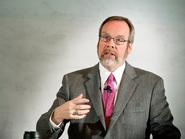
Every year, Hamilton’s chapter of Phi Beta Kappa—the oldest academic honor society in the United States—holds a lecture in honor of Richard Couper ’44. The lecture series, which began in 2005, focuses on the library collections and the institutions themselves, as Couper was a major benefactor of Burke Library. This year’s Couper Phi Beta Kappa Lecture Series speaker was Kevin Smith ’81, scholarly communications officer of Duke University’s Perkins Library. His presentation, titled “From Schopenhauer to Schwarzenegger: The Impact of Copyright on Art and Scholarship in the Digital Age,” took place on Oct. 6.
Vice President for Information Technology David Smallen introduced Smith’s lecture with a brief discussion of copyright infringement. Smallen mentioned the realization that many students come upon with respect to file sharing: “even though it’s quite easy to share [media] with friends, it isn’t necessarily legal.”
Smith began his presentation by explaining the “copyright dilemma.” Since the implementation of automatic copyrighting in 1989, artists no longer need to register their copyrights. As a result of this policy change, “copyright became the wholly-encompassing environment in which art and scholarship exist.”
The original laws for copyrighting were established early in United States history and appear in Clause 8 of Article 1, Section 8 of the Constitution, which states that “Authors and inventors” have the ability to secure, for “limited times,” the “exclusive right to their respective writings and discoveries.” Smith shared that this is the only clause in the entire Constitution with an explicit objective: “To promote the progress of science and useful arts.”
Although copyright laws protect the original work of an author or artist, transformative works—those in which “no more of the original work is used than is necessary to make a point”—or forms of parody are fair uses of copyrighted material. However, the line between parody and plagiarism is very fine. One of Smith’s primary examples of copyright infringement was a sequel to J.D. Salinger’s The Catcher in the Rye. Published under the pseudonym John California, the book was called 60 Years Later: Coming Through the Rye. Whereas California might have intended for his book to play on some of the elements of Salinger’s classic novel, the pervasive use of the word “phony” in both works appeared to judges as a troublesome borrowing when Salinger brought the case to court.
“The assumption that copyright provides the incentive for creation is often false,” said Smith. He emphasized that, while copyrighting is a fairly effective means of protecting assets for commercial artists, independent artists and scholars do not experience the same benefits.
While pop stars and famous authors might succumb to the appeal of money and fame, scholarly authors produce their work in the hopes of making an intellectual impact. “The reward system exists entirely outside of copyright for scholars,” Smith said. He explained that prior to the Digital Age, copyright was not a determining factor in the publication of scholarly journals. Print publications were expensive, though, and circulated less quickly than the electronic media students and educators are now able to access. Journals now account for 65 percent of library budgets, Smith noted.
The most important issue scholars confront when dealing with copyright is that of attributing ideas. According to law, publishers have no moral responsibility toward scholarly authors but rather an economic one. As a result, some authors do not receive proper recognition when their ideas are recycled—a reward that is, arguably, more important to them than remuneration.
Copyright and the idea of fair use apply directly to life on a college campus. “Everyday—whether you know it or not—as academics, you are making risk assessments” with respect to fair use, Smith said. The citations that students and educators choose to include or omit and the computer files that they utilize have legal implications. But the concept of fair use is “intentionally flexible,” as advancements in technology require new accommodations. In the future, Smith believes that people should “fight to preserve broad and flexible fair use” of materials, as well as “leverage ownership to benefit scholarship.”
Posted October 7, 2011
